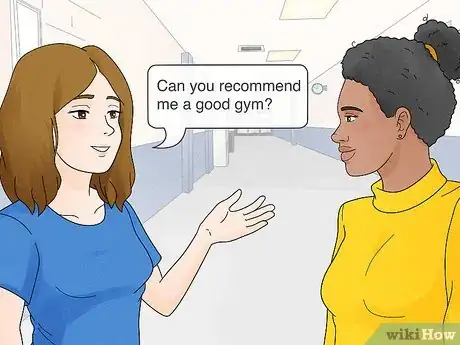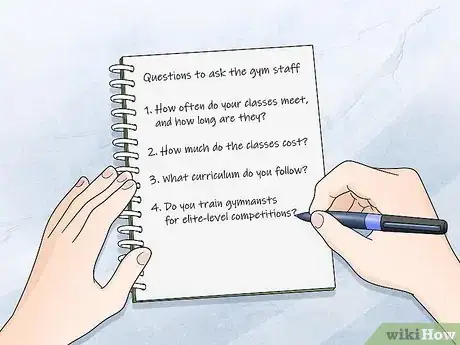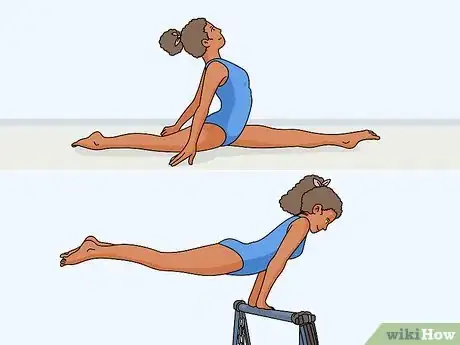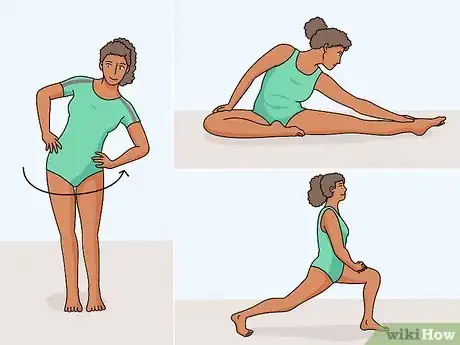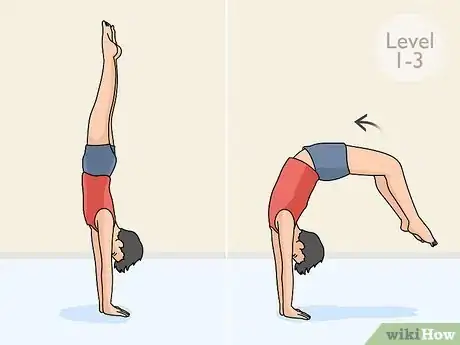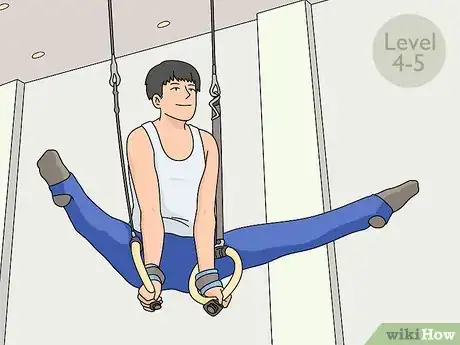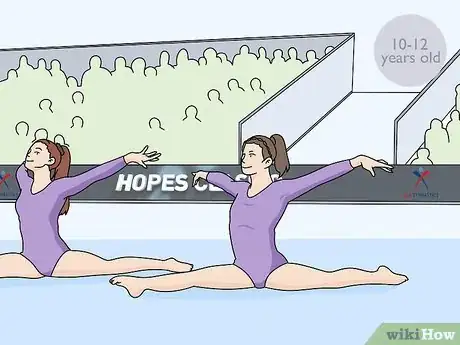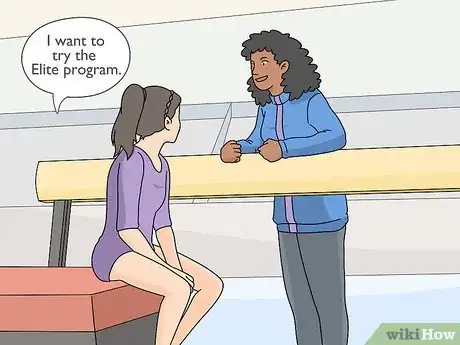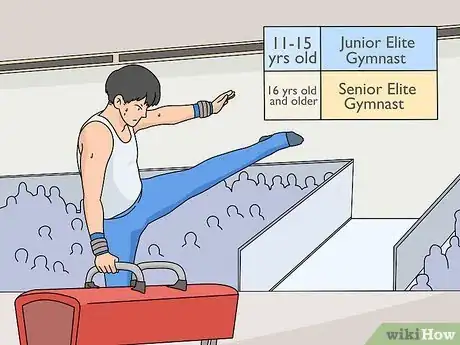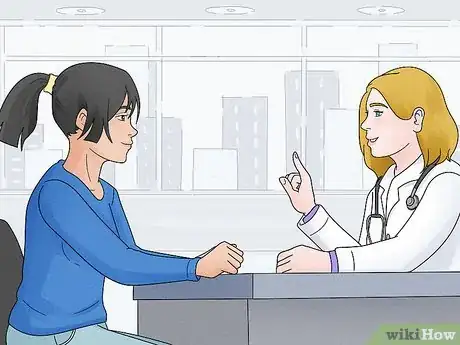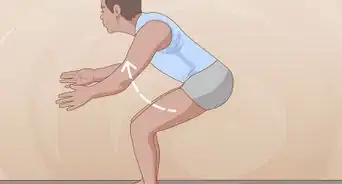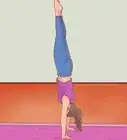This article was co-authored by Tanya Berenson and by wikiHow staff writer, Megaera Lorenz, PhD. Tanya Berenson is a Gymnastics Instructor and the General Manager of the Los Angeles School of Gymnastics. With over 25 years of professional gymnastics experience, Tanya has also served as a consultant to USA Gymnastics, has served as the USA World Maccabi Games Head Coach, USA Gymnastics Meet Director, and RAS counselor. She holds a B.Ed. in Early Childhood Development from the University of California, Los Angeles.
There are 21 references cited in this article, which can be found at the bottom of the page.
This article has been viewed 251,173 times.
If you’ve ever watched gymnasts performing amazing feats at the Olympics, you may have dreamed of competing at the elite level. Becoming an elite gymnast is difficult, but you can achieve it if you’re able to put in the time and dedication to master the basic skills and move up through the ranks. Start by finding a gym in your area with a gymnastics program that can train you to the elite level. Be ready to put in long hours and set realistic goals for yourself. Don’t forget to take time to relax and care for your mind and body so you don’t burn out!
Steps
Finding a Gym
-
1Choose a gym with gymnastics governing body membership. If you want to train to the elite level, it’s important to find a gym that meets the right standards of excellence and offers the right kind of training. Check that the gym is a member of your country’s national governing body for competitive gymnastics, such as USA Gymnastics in the U.S.[1] [2]
- Most national gymnastics governing bodies are affiliated with FIG (Fédération Internationale de Gymnastique), the international governing body for competitive gymnastics.
- If you live in the U.S., you can find USA Gymnastics member gyms by using the USA Gymnastics search directory: https://usagym.org/pages/find/gym.html.
Be aware: USA Gymnastics member gyms are required to meet specific guidelines for safety and ethics. Ask to see a copy of your potential gym’s code of conduct policy and liability insurance information.[3]
-
2Ask other gymnasts or gymnastics parents for recommendations. If you know anyone else who does gymnastics, they may be able to recommend a great gym or coach in your area. You can also try asking a coach at your school for recommendations. When you visit a potential gym, chat with other gymnasts or their parents to find out if they like the program.[4]
- Explain that you’re interested in serious, competitive training and would like to reach the elite level. That way, you’re more likely to get recommendations for gyms that have competitive rather than informal or recreational programs.
- If you don’t know anyone who does gymnastics, read online reviews of gymnastics programs in your area.
Advertisement -
3Bring a list of questions to ask the gym staff. Before you visit a gym, write out a list of questions about their gymnastics program. This will help you get an idea of what you’re getting into and how well the gym can meet your needs. Some good questions to ask include:[5]
- How often do your classes meet, and how long are they?
- How much do the classes cost?
- Can I try out a class or try working with a couple different instructors to make sure I like them before signing up?
- What curriculum do you follow?
- Do you train gymnasts for elite-level competitions?
-
4Visit the gym to make sure it has a range of well-maintained training equipment. Before you sign up for a gymnastics program, stop by the gym and ask to have a tour of the gymnastics training facilities. Take a look around and make sure that:[6]
- The equipment looks clean and is in good shape
- There’s a wide variety of training equipment, such as vaults, bars, trampolines, pits, and tumble tracks
- There are mats, spotting belts, and other safety equipment in place
- The gym is well-lit and there are viewing areas for parents who want to keep an eye on their kids’ training
-
5Watch a class in action to see if it meets your needs. If the gym looks good, ask if you can sit in on a class to see what it’s like. Check that the coaches and staff seem engaged, friendly, and concerned about the gymnasts’ wellbeing. You can also get a sense of whether the gymnasts are enjoying themselves.[7]
- Pay attention to things like the number of gymnasts in the class and the range of ages and experience levels among the gymnasts. You’ll probably get better training if the classes are small and you’re with other gymnasts at a similar age and skill level.
-
6Meet the coaches and staff to get a sense of what they’re like. Before you sign up, chat with coaches and other staff members you might be working with. Make sure they seem committed to safety and that they’re willing to help you set good goals for yourself as you train to the elite level.[8]
- Let them know that you’re interested in becoming elite and ask how they train gymnasts who are interested in serious competitive training.
- Trust your instincts and don’t be afraid to try working with a couple different coaches until you find the right one for you.
Starting to Practice
-
1Start training as young as possible. Technically, there’s no maximum age limit for becoming an elite gymnast. You can start any of the training levels at any age at or above the minimum age requirement. However, it’s no secret that younger, smaller gymnasts have an advantage.[9] In order to build the skills you need to become an elite gymnast while you’re still in your teens, start training while you’re a child if you can.
- On average, elite gymnasts start training at around 4 years of age. Some, such as Simone Biles, start as late as age 6, while others may start training as young as 2 or even 1!
- Children can start learning the fundamental skills for gymnastics as young as 2-3 years old.[10] However, many programs require that kids are at least 6 years old before they begin training for serious competitions.[11]
-
2Be prepared to train at least 30 hours a week. Elite gymnasts have to put in serious training time in order to stay in shape and keep their skills sharp. While the exact number of hours you’ll need to spend training aren’t set in stone, most elite gymnasts train for about 30 hours each week.[12] Gradually increase the hours you spend in the gym as you advance through the different training levels.
- When you first begin training, you might start out at about 6-8 hours a week, depending on your age, your training program, and how much time you have.
-
3Master the basic gymnastics skills. While flashy, advanced gymnastics skills might seem more exciting and impressive, they’re all built on a solid foundation of more basic skills. Focus on being able to do the simple, foundational skills before you try to learn anything fancy. Some good starting skills to learn include:[13]
- Handstands
- Casting
- Splits
- Handsprings
- Roundoffs
- Turns
-
4Incorporate strength training into your routine. It takes a lot of strength to perform elite-level gymnastics. Gymnastics coaches use special strength training routines that are ideal for gymnasts. Talk to your coach about which exercises can help maximize your strength without causing your muscles to become too big. Your routine might include exercises like:[14]
- Handstand pushups and presses
- Straight arm lat pulldowns
- Casting to a handstand
- Flys
- Pull-ups
-
5Stretch regularly to improve your flexibility. Being flexible is another key to success as a gymnast. To keep your joints and muscles limber, add stretches and range-of-motion exercises to your regular workout routine. Ask your coach to help you choose stretches that will be safe and helpful for you.[15]
- Before you start stretching, warm up your joints by moving them slowly in a circle, both clockwise and counter-clockwise.
- Do static stretches, in which you hold a stretch for about 10 seconds, to help loosen your muscles and prevent strains and sprains.
- Do dynamic stretches, such as kicks or lunges, to help warm up your muscles and improve your circulation.
Progressing through the Ranks
-
1Join a Junior Olympics (JO) program. The Junior Olympics program is a training program with several levels. In this program, you will master the basic skills you need at each level to advance to the next stage of your training. Once you pass Level 10 in the Junior Olympics program, you can start training as an elite gymnast. Look for a gym in your area that offers a JO program.[16]
- “Elite” is the highest rank you can achieve in a JO program. Level 10 gymnasts are considered “Pre-Elite.”
- Other types of training programs, such as the USA Gymnastics Xcel program, are designed to help you build similar skills. However, the Xcel program does not train gymnasts at the elite level.[17]
-
2Develop foundational skills in levels 1-3. During the first 3 levels of the JO program, you’ll learn the basic “compulsory” skills that form the foundation of more advanced gymnastics. If you want, you can start competing with other gymnasts in your age group once you reach Level 3.[18]
- Gymnasts need to be at least 6 years old before they can qualify for Level 3.
- Some Level 3 gymnastics skills include handstands, pullovers, a leap with a 90° split, and round-off back handsprings.
-
3Start competing for state championships at Levels 4-5. In Levels 4-5, you’ll build on the standard skills that you started learning in Levels 1-3. Start signing up for serious state and regional competitions once you reach these levels so that you can build your confidence and prepare for the intense competitiveness of the elite level.[19]
- A gymnast has to be at least 7 years old to graduate to Level 4 or 5.
- You’ll also need to meet certain prerequisites before you can reach these levels, such as a 75% proficiency level at Level 3 vault, bars, beam, and floor skills, and a mobility score of 34.00 AA.
- Some Level 4-5 skills include front handsprings, kips, sole circles, 150° split leaps, and saddle jumps.[20]
-
4Work with your coach to create optional routines at levels 6-10. During the first 5 levels, you’ll be practicing standardized skills and routines that are required for all gymnasts. Once you get into the upper levels, however, you’ll need to start developing your own routines that show off your special strengths. These are called “optional” routines. Talk to your coach about how to put together a competitive routine while continuing to build your compulsory skills.[21]
- You have to be at least 8 years old to reach Level 8, and at least 9 years old to reach Level 10.
- You’ll need to meet minimum proficiency and mobility scores at each of these levels before you can advance to the next level.
- Level 10 is the highest level you can reach before you’re considered an elite gymnast.[22]
Advancing to Elite through a TOPS/Hopes Program
-
1Try out for a TOPS program for special Pre-Elite training if you’re age 7-10. The TOPS program is a special USA Gymnastics program for skilled young Junior Olympics gymnasts who are hoping to reach the Elite level. Talk to your coach about whether this program is a good fit for you. If so, you can participate in testing for TOPS, and if you qualify, you may be selected for special training and competitions to help you advance through the ranks.[23]
- The state TOPS test happens in June and July, followed by the national TOPS test in October. If you qualify for TOPS, you’ll be invited to join a special training camp that takes place every December.
- You’ll be tested not only on your gymnastics skills, but also on your physical abilities (such as your ability to do a rope climb, do a press handstand, or perform leg lifts). The qualifying tests for TOPS vary based on your age.
Tip: Being selected for TOPS or Hopes doesn’t automatically make you an Elite gymnast, but these programs are great stepping stones for serious athletes who are hoping to eventually compete at the Elite level.
-
2Apply for a Hopes program if you’re 10-12 years old. The Hopes program is for highly skilled Junior Olympics gymnasts aged 10-12 who aren’t quite ready to move on to the elite level. Talk to your coach about trying out for one of these programs so that you can train and compete alongside the elite gymnasts on your team until you’re ready to move up to the elite level.[24]
- To compete as a Hopes gymnast at the US Challenge, you’ll need to earn a compulsory score of 32.0 and an optional score of 46.5 at a regional or national competition.
-
3Talk to your coach about trying out for the Elite program. As a TOPS or Hopes gymnast, you’ll have opportunities to test for the elite program at the regional and national level.[25] Work with your coach to figure out when you’re ready to participate in the national qualifiers.
- If you’re moving into a junior elite program (for gymnasts aged 11-15) from TOPS or Hopes, you’ll need a 35.0 compulsory score and a 53.0 optional score to qualify for the Classics. To qualify for the USA’s, you’ll need a 35.0 compulsory and a 54.0 optional score.[26]
-
4Compete in regional and national championships at the higher levels. Once you reach Levels 8-10, you’ll have more competitive opportunities than at the earlier levels. These include championship competitions at the regional and national levels. Talk to your coach about how to complete the requirements for entering these competitions.[27]
- These larger competitions will require you to do more difficult routines and will be judged according to a different set of standards from lower-level competitions.
- The rules for Level 8-10 competitions are based on international guidelines set by the Fédération Internationale de Gymnastique.[28]
-
5Participate in an elite qualifying competition. Once you successfully master the Pre-Elite skill set, you can try out for the Elite Program.[29] Work with your coach to prepare for the qualifying competitions, which will consist of both compulsory and optional routines.[30]
- The specific scores you’ll need to achieve at each qualifying event will depend on your age group and which types of qualifying events you participate in.
- You must be 11-15 years old to become a Junior Elite gymnast, and 16 years or older to become a Senior Elite gymnast.
- Once you become an Elite gymnast, you may qualify to join the National Team and participate in international competitions.
Supporting Your Training
-
1Set SMART goals for your training. You can make a big dream like becoming an elite gymnast feel more manageable by breaking it down into smaller, shorter-term goals. Set goals for your training that are specific, measurable, attainable, relevant, and time-bound.[31]
- For example, you might have a big goal of reaching Level 5 by the end of the year. You can split this up into smaller goals, such as practicing a move on the bars a certain number of hours per week or perfecting your split jump by the end of the month.
- Your coach can help you set realistic and helpful goals for your training based on your strengths and current skill level.
-
2Practice self-care to prevent burnout. Being an elite gymnast is very difficult, and it’s easy to get burnt out and lose your sense of joy in the sport.[32] To keep this from happening, care for yourself physically and emotionally. Some ways to care for yourself include:
- Spending time with supportive friends and family
- Eating nutritious meals
- Getting plenty of sleep
- Doing relaxing activities, like watching TV, reading, or doing creative projects
Warning: Competitive gymnasts are vulnerable to a variety of health problems, including injuries and eating disorders. Work closely with your doctor to make sure you stay physically, mentally, and emotionally healthy during your training.
-
3Work with your doctor or a nutritionist to maintain a healthy diet. Getting the right nutrition can be challenging when you’re training to be an elite gymnast. Talk to your coach, doctor, and a nutritionist or dietitian about what you should be eating to manage your weight in a healthy way and get the nutrients you need.[33]
- Most gymnasts need a diet rich in carbohydrates and protein in order to maintain energy and build strong muscles during training. However, the exact type of diet you need might vary depending on your style of gymnastics.
- Make sure you also eat a variety of fruits, vegetables, and healthy fats (like those found in fish, nuts and seeds, and vegetable oils) in order to get all the vitamins and minerals you need.
-
4Apply for a financial assistance grant to help pay for training. Competitive gymnastics training can be very expensive. Between the cost of tuition, equipment, travel, and other expenses and fees, you and your family can end up paying up to $15,000 per year.[34] If you aren’t able to afford the costs of your training, try applying for grants, such as the Acrobatic Gymnastics Foundation’s Athlete Assistance Grant.[35]
- If you’re not sure how to apply, ask your coach if they can help.
- If you don’t qualify for a grant, consider raising funds from family and friends through a crowdfunding platform, such as GoFundMe or MakeAChamp.
Expert Q&A
Did you know you can get premium answers for this article?
Unlock premium answers by supporting wikiHow
-
QuestionWhat are the best exercises for strengthening weak arms?
 Tanya BerensonTanya Berenson is a Gymnastics Instructor and the General Manager of the Los Angeles School of Gymnastics. With over 25 years of professional gymnastics experience, Tanya has also served as a consultant to USA Gymnastics, has served as the USA World Maccabi Games Head Coach, USA Gymnastics Meet Director, and RAS counselor. She holds a B.Ed. in Early Childhood Development from the University of California, Los Angeles.
Tanya BerensonTanya Berenson is a Gymnastics Instructor and the General Manager of the Los Angeles School of Gymnastics. With over 25 years of professional gymnastics experience, Tanya has also served as a consultant to USA Gymnastics, has served as the USA World Maccabi Games Head Coach, USA Gymnastics Meet Director, and RAS counselor. She holds a B.Ed. in Early Childhood Development from the University of California, Los Angeles.
Gymnastics Instructor Knee-ups, chin-ups, and pull-ups are all great for upper body strength training. You can use a single bar for this. In fact, there are some you can drape over your door wall, and others that you can drill into the wall or suction into place. Just make sure to always stretch before doing any kind of strength training.
Knee-ups, chin-ups, and pull-ups are all great for upper body strength training. You can use a single bar for this. In fact, there are some you can drape over your door wall, and others that you can drill into the wall or suction into place. Just make sure to always stretch before doing any kind of strength training. -
QuestionHow can I become a great gymnast without going to the gym?
 Tanya BerensonTanya Berenson is a Gymnastics Instructor and the General Manager of the Los Angeles School of Gymnastics. With over 25 years of professional gymnastics experience, Tanya has also served as a consultant to USA Gymnastics, has served as the USA World Maccabi Games Head Coach, USA Gymnastics Meet Director, and RAS counselor. She holds a B.Ed. in Early Childhood Development from the University of California, Los Angeles.
Tanya BerensonTanya Berenson is a Gymnastics Instructor and the General Manager of the Los Angeles School of Gymnastics. With over 25 years of professional gymnastics experience, Tanya has also served as a consultant to USA Gymnastics, has served as the USA World Maccabi Games Head Coach, USA Gymnastics Meet Director, and RAS counselor. She holds a B.Ed. in Early Childhood Development from the University of California, Los Angeles.
Gymnastics Instructor Online virtual training is fantastic—it's like gymnastics without borders. You can obtain training from instructors all over the world, and even attend camps and master classes. The great thing with virtual training is that you can either take a live class or revisit it later. It just provides a lot more flexibility on areas of instruction.
Online virtual training is fantastic—it's like gymnastics without borders. You can obtain training from instructors all over the world, and even attend camps and master classes. The great thing with virtual training is that you can either take a live class or revisit it later. It just provides a lot more flexibility on areas of instruction. -
QuestionWhat are the most important qualifications for a gymnastics coach?
 Tanya BerensonTanya Berenson is a Gymnastics Instructor and the General Manager of the Los Angeles School of Gymnastics. With over 25 years of professional gymnastics experience, Tanya has also served as a consultant to USA Gymnastics, has served as the USA World Maccabi Games Head Coach, USA Gymnastics Meet Director, and RAS counselor. She holds a B.Ed. in Early Childhood Development from the University of California, Los Angeles.
Tanya BerensonTanya Berenson is a Gymnastics Instructor and the General Manager of the Los Angeles School of Gymnastics. With over 25 years of professional gymnastics experience, Tanya has also served as a consultant to USA Gymnastics, has served as the USA World Maccabi Games Head Coach, USA Gymnastics Meet Director, and RAS counselor. She holds a B.Ed. in Early Childhood Development from the University of California, Los Angeles.
Gymnastics Instructor
References
- ↑ https://gymnasticshq.com/tips-for-choosing-a-gymnastics-gym/
- ↑ Tanya Berenson. Gymnastics Instructor. Expert Interview. 22 May 2020.
- ↑ http://www.usagymparents.com/faq/
- ↑ http://www.usagymparents.com/faq/
- ↑ http://www.usagymparents.com/faq/
- ↑ https://gymnasticshq.com/tips-for-choosing-a-gymnastics-gym/
- ↑ http://www.usagymparents.com/faq/
- ↑ https://gymnasticshq.com/tips-for-choosing-a-gymnastics-gym/
- ↑ https://www.npr.org/templates/story/story.php?storyId=90105904
- ↑ https://usagym.org/pages/home/publications/technique/2003/1/starting.pdf
- ↑ https://usagym.org/pages/women/pages/overview_jo.html
- ↑ https://www.ncbi.nlm.nih.gov/pmc/articles/PMC3751410/
- ↑ https://gymnasticshq.com/9-basic-gymnastics-skills-you-should-master/
- ↑ https://www.usagym.org/pages/home/publications/technique/1996/8/strength.pdf
- ↑ http://web.mit.edu/tkd/stretch/stretching_5.html#SEC38
- ↑ https://usagym.org/pages/women/pages/overview_jo.html
- ↑ https://www.farmington.k12.mn.us/UserFiles/Servers/Server_116048/File/Community%20Education%20Files/Youth/TNT/Understanding%20Competitive%20Gymnastics-Parent%20guide.pdf
- ↑ https://www.farmington.k12.mn.us/UserFiles/Servers/Server_116048/File/Community%20Education%20Files/Youth/TNT/Understanding%20Competitive%20Gymnastics-Parent%20guide.pdf
- ↑ https://usagym.org/pages/women/pages/overview_jo.html
- ↑ https://gymnasticshq.com/level-5-gymnastics-requirements/
- ↑ https://usagym.org/pages/women/pages/overview_jo.html
- ↑ https://usagym.org/pages/women/pages/overview_jo.html
- ↑ https://usagym.org/pages/women/pages/overview_tops.html
- ↑ https://usagym.org/PDFs/Women/ElitePre-Elite/08hopes.pdf
- ↑ https://usagym.org/pages/women/pages/overview_elite.html
- ↑ https://usagym.org/PDFs/Women/ElitePre-Elite/08hopes.pdf
- ↑ https://usagym.org/pages/women/pages/overview_jo.html
- ↑ https://www.farmington.k12.mn.us/UserFiles/Servers/Server_116048/File/Community%20Education%20Files/Youth/TNT/Understanding%20Competitive%20Gymnastics-Parent%20guide.pdf
- ↑ https://usagym.org/pages/women/pages/overview_elite.html
- ↑ https://usagym.org/PDFs/Women/ElitePre-Elite/20elitechart.pdf
- ↑ https://usagym.org/pages/home/publications/technique/1997/9/goal.pdf
- ↑ https://pdfs.semanticscholar.org/44cb/fa852c45f54dca7e7756c0fad6352187d016.pdf
- ↑ https://usagym.org/docs/Home/120610_weightmanagement.pdf
- ↑ https://abcnews.go.com/US/olympics/olympians-parents-feel-debt-achieving-gold/story?id=16940902
- ↑ https://usagym.org/pages/post.html?PostID=21192


